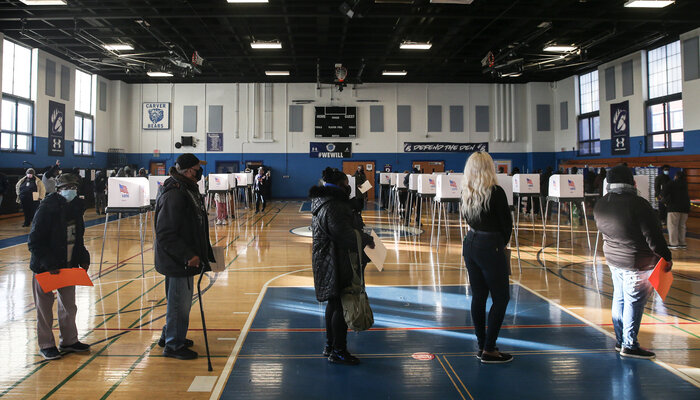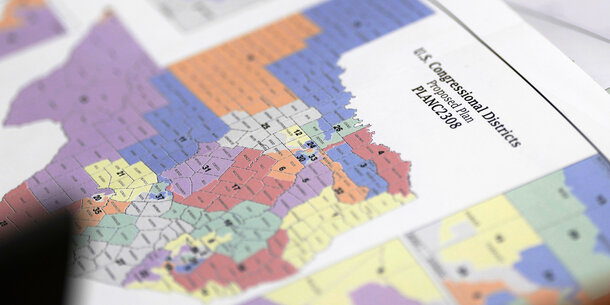With legislative and congressional districts redrawn every 10 years, political parties have often produced maps that entrench majority control. While this dynamic has long pervaded American politics, the last redistricting cycle, in 2011–12, saw some of the worst partisan gerrymandering and racially discriminatory maps in history — a development that has further diluted the political power of communities of color. At the same time, there has been growing momentum for reforms, including in states pushing to establish independent redistricting commissions. In a new paper, The Redistricting Landscape, 2021–22, the Brennan Center’s Michael Li looks ahead to the map-drawing cycle that starts this year and outlines the political, legal, and demographic factors at play, along with how census delays caused by Covid-19 might affect the process.
What factors have contributed to increased partisan gerrymandering in the United States?
Michael Li: Redistricting has always been a politically fraught process in the United States, going back to the founding of the country. Patrick Henry, then governor of Virginia, famously tried to draw Virginia’s very first congressional map to make it so that James Madison couldn’t win a seat. But political manipulation of maps is getting worse for both legal and pragmatic reasons. The legal reason is that the Supreme Court ruled in 2019 that federal courts cannot hear partisan gerrymandering claims. That’s a big signal to map drawers that they can do whatever they want and that there won’t be a cop on the beat.
Add to that the increase in single-party control of the redistricting process in recent decades. Whether it’s Democratic or Republican control, that’s a recipe for map drawing based primarily on political considerations. After the Tea Party wave election of 2010, Republicans consolidated control in states such as Alabama, Wisconsin, and Pennsylvania, and they used that power aggressively. Likewise, this decade, lots of states will draw maps again under single-party control, particularly in the South.
What’s more, it’s getting easier to draw discriminatory maps. In the past, you had to draw maps by hand or with slow computers, and you had to pick the best out of the three, four, five, or six maps that you drew. But now, you can draw thousands of maps in a matter of minutes, with much more sophisticated data and analytics. It’s not just election results and demographics but also, increasingly, the sort of consumer data that political campaigns and commercial companies use about voters, based on what kind of car you drive, what magazines you read, who you donate to. That enables map drawers to build a robust profile of who you are, whether you’re a Democrat or a Republican, and how likely you are to vote in presidential years and midterms. And that, in turn, enables you to draw maps with micro-precision to perform the way that they’re designed to. It’s deeply undemocratic because it basically renders elections meaningless. And it’s only going to get worse as these tools become even more powerful.
What outcomes are produced by gerrymandering?
Li: Gerrymandering disproportionately targets communities of color, especially in the South. Because of residential segregation, it’s easy to either combine or split apart communities of color in order to achieve a political effect. By contrast, there are relatively fewer white Democrats in the South, and they tend to live in close proximity to white Republicans — sometimes in the same house. That makes it harder to combine or split white Democrats in the same way.
The result of such targeting is that those communities of color are deprived of the ability to elect candidates who represent their interests. That’s a huge problem because, as we’ve seen over the past year, there’s a whole host of issues, from policing to the pandemic, where it is important to have diverse perspectives at the table.
Redistricting reform would contribute to more equitable outcomes for communities of color. It would eliminate the ability of any one party to make all of the decisions, and it would give communities of color more legal tools to argue for districts that are electorally favorable.
How will Covid-related delays to census data delivery affect the next redistricting cycle?
Li: This upcoming redistricting cycle will take place much later than normal. Usually, most states complete the redistricting process by the end of summer. This time, because of Covid-related delays, states likely won’t even get census data until September 30 or perhaps even a bit later, after which it will need to be processed. So, redistricting probably can’t start in earnest until late October or November, which will create complexities in a number of states.
From a legal standpoint, some states will have to make emergency changes to the deadlines that are in their laws. Redistricting in a lot of states will take place in a special session, which is oftentimes a rushed affair with fewer procedural protections. The governor or legislative leaders often control the timing of these special sessions, which means that there’s the potential not only for gaming the process but also for pushing redistricting to the last minute, which will give less time for judicial review of discriminatory maps.
The potential short-circuiting of litigation time is especially worrying. Historically, redistricting was done by the summer, which gave you at least six to nine months to bring legal challenges to try to win changes to maps before they went into effect. Now, you may have weeks instead of months, which increases the likelihood that discriminatory maps will be used for at least the 2022 elections before changes get ordered in. That, again, will cut sharply against communities of color.
What reforms would contribute to a fairer redistricting process?
Li: The good news is that there are lots of ways to make the process better. By far the strongest way is for states to establish independent commissions that have strong rules for drawing maps, independently select commissioners, remove political parties from direct roles in the process, require pan-partisan support in order to pass a map, and allow for public participation and transparency in the process. A well-designed commission creates a system of checks and balances to ensure that even if something goes awry — if, for example, there is a rogue commissioner — there are safeguards.
Reforms such as independent redistricting commissions help make that process public and enable people to see what is going on and to submit their own thoughts. Drawing maps requires balancing competing demands, and that often can be contentious. People are going to disagree. But at least those debates and tradeoffs occur in public and not in backrooms.
What kind of momentum is there for redistricting reform?
Li: A record six states passed some sort of restricting reform in the last decade, including Colorado and Michigan, which adopted strong, well-designed independent commissions. There probably would have been more if not for the pandemic, which made it hard to collect signatures for ballot initiatives. There definitely is momentum building toward redistricting reform. It’s an issue that resonates with people in ways that it didn’t before. It moves people in the polls. That shift in public opinion is increasingly influencing how lawmakers respond. We saw reforms pass on a bipartisan basis in Virginia and New Hampshire, and there’s bipartisan momentum in states including Pennsylvania, because lawmakers are responding to what voters want. And they also understand that the system is not right.
All of that builds toward federal legislation. The For the People Act, which is modeled on successful state reforms, would establish a uniform set of rules for how congressional redistricting is done nationwide and provide for greater transparency and public participation in the process. It also would require states to draw congressional districts using independent commissions, though whether it can be in place in time to shape the 2022 elections will depend on when the Senate passes the bill.
Gerrymandering is one of the hot-button issues of our time. If you look at polling, ending gerrymandering is one of the few things that gets majority support from Democrats, Republicans, and independents. It’s something that people feel strongly about. People understand instinctively that the political process is broken, and they understand that rigged maps are in part to blame.
The For the People Act’s reforms are designed to help create a democracy that looks like America, that is responsive to the concerns of Americans, and that isn’t dominated by special interests, including those that played a role in rigging the maps in the first place.
Read the full Brennan Center paper, The Redistricting Landscape, 2021–22.




